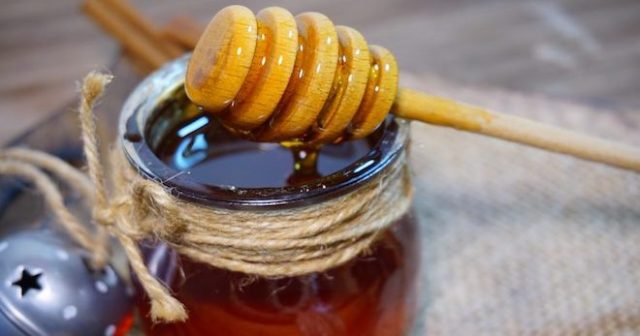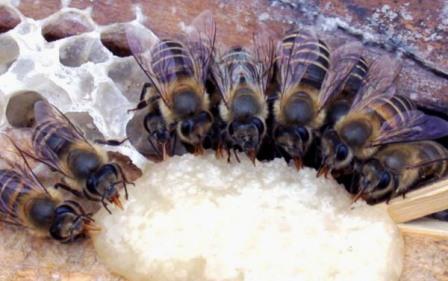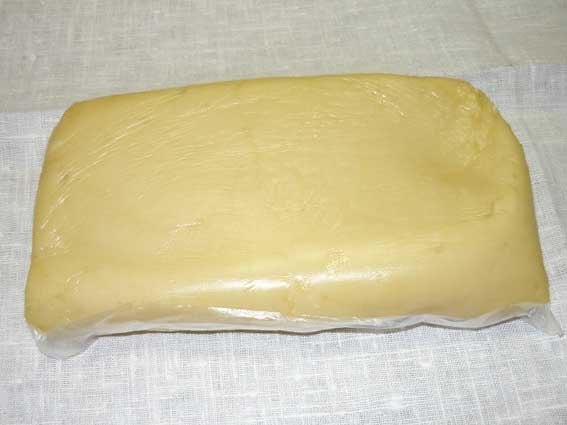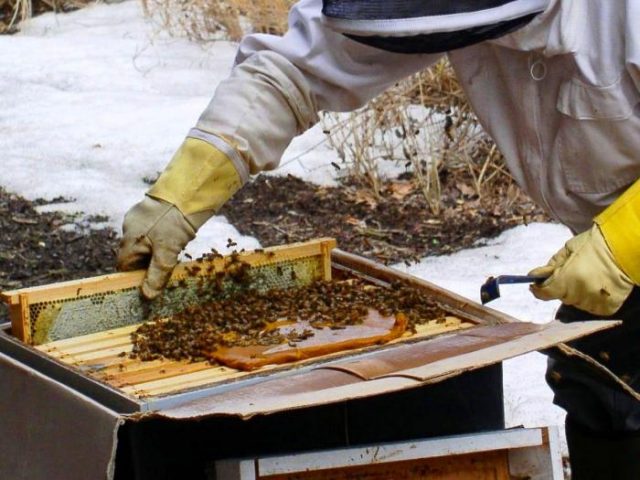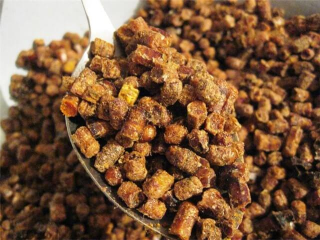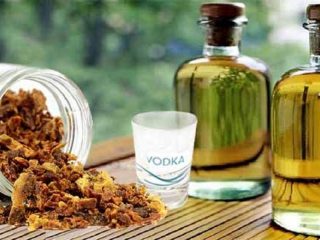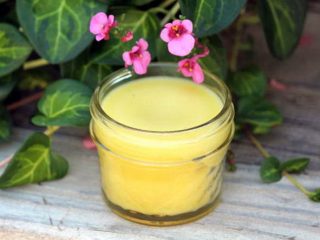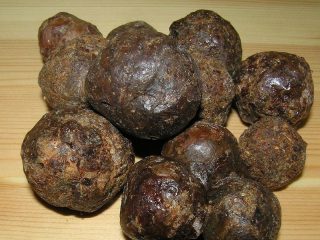Content
Many novice beekeepers in the early years of beekeeping, striving with all their might to preserve the health of insects, are faced with such a nuance as feeding bees for the winter. The expediency of this procedure often causes controversy in certain circles, and therefore it is worthwhile to understand this issue in more detail.
What bees eat in winter
The mode of life of honey bees in the winter months is as smooth as in the spring and summer. With the onset of cold weather, as soon as the queen stops worming, worker bees begin to form a winter club, which is designed to keep the hive warm for the winter. While in the club, insects become less active and move only to maintain the temperature of the nest or to eat.
Under natural conditions, bees use bee bread and honey for the winter. This food is considered the most useful and nutritious food for maintaining the health of the bee colony, as it contains many different vitamins and minerals. However, not all honey can be used to feed bees in winter.
Health for the whole winter to a family of bees will be provided by honey:
- meadow forbs;
- cornflowers;
- white acacia;
- sweet clover;
- sow thistle;
- linden;
- snakehead;
- creeping thyme.
At the same time, honey obtained from some other plants can harm the bee community, weakening insects and provoking the appearance of diseases. So, the danger for the winter is the feeding of bees with honey:
- from plants of the willow family;
- cruciferous crops;
- rapeseed;
- buckwheat;
- heather;
- cotton;
- marsh plants.
The honey of these plants tends to crystallize quickly, which makes it very difficult for bees to process it and they begin to starve. Therefore, for the winter, frames with such honey must be pulled out of the hive, replacing it with other varieties.
The crystallization process of honey directly depends on the color of the honeycomb. For the longest time in a liquid state, it is in light brown combs, therefore, when preparing top dressing for the winter, it is necessary to focus on this feature.
A great danger is the honeydew honey left for feeding for the winter. Pad is a sweet liquid mass that small insects, for example, aphids, and some plants secrete during their vital activity. In the presence of favorable conditions and a large number of honey flowers in the apiary, bees do not pay attention to the honeydew, but if there are too many insect pests or honey collection is impossible, the bees have to collect the honeydew and carry it to the hive, where it is then mixed with honey. Feeding with such a product, due to the lack of necessary substances, can cause diarrhea in insects and lead to their death. To avoid such a development of events, you should carefully monitor the regime and check honey for winter feeding for bees for the presence of honeydew.
Do I need to feed the bees for the winter
Studies show that a lack of nutrients in the winter is the cause of many disruptions in the life and work of the bee colony. Bees wear out faster, become less active, which leads to a decrease in the amount of honey and brood.
However, many experienced beekeepers do not approve of the practice of feeding bees for the winter and try to resort to it as little as possible. Instead, the owners of apiaries have been paying attention since summer to ensure that their pets have a sufficient amount of food in the cold season.
Winter feeding is appropriate only in special cases, if required:
- replace low-quality or crystallized honey;
- replenish food supplies in the event of a shortage;
- prevent the development of certain diseases.
How to feed bees in winter if honey is not enough
For various reasons, it sometimes happens that there is not enough honey and bee bread for feeding in winter. In such a confluence of circumstances, it is imperative to provide the bee colony with the missing food in order to increase its chances of survival. To do this, you should inspect the bees and introduce a suitable type of feeding. Before feeding, you should calculate the amount of food needed and make sure that the timing for the procedure is favorable.
When to start feeding bees for the winter
If bees still need additional nutrition, then the timing of feeding in the winter should fall at the end of February - beginning of March, but not earlier. During this period, insects are already gradually moving away from stasis and anticipating an imminent spring, so human intervention will not be as stressful for them as in the first winter months.
But earlier feeding will do nothing but harm, since insects will be disturbed and can get sick due to temperature jumps. In addition, an abundance of food will provoke uterine worming. Brood will appear in the cells, and the usual way of life of the bees will be disrupted, which can be fatal in winter.
How much food to leave bees for the winter
Regarding winter nutrition, perhaps the most burning question is how much food bees need for the winter. Usually the amount of food depends on the strength of the colony and the number of frames in the hive.
So, one nesting frame with an area of 435x300 mm, which includes up to 2 kg of feed, will be enough for one bee family for a month of wintering. Upon completion of the preparatory work for the winter, namely, in mid-September, a family of bees sitting on 10 frames should have from 15 to 20 kg of honey and 1 - 2 frames of bee bread for feeding.
How to feed bees for the winter
When honey and bee bread cannot be used for feeding, experienced beekeepers use the following feed options that allow bees to survive until spring:
- sugar syrup;
- kandy;
- sugar candy;
- bee bread substitute mixture.
Each type of winter feeding has its own advantages and features of laying, but all of them will help maintain the vitality of the bee family before warming begins.
Preparing feed for bees for the winter
Sugar syrup is a fairly common way of feeding bees in winter, but without additional inclusions it is not nutritious, therefore it is often enriched with additives with herbs. Some beekeepers do not recommend using it before the cleaning flight, as it takes too much energy for the insects to process it.
Kandy, a specially prepared mass mixed with honey, pollen and powdered sugar, has proven itself much better for feeding bees in winter. Often, its composition includes medicines, which not only saves bees from hunger, but also serves as a prophylaxis against various diseases. The advantages of kandy as a top dressing are that it does not excite the bees and makes it easier for the insects to adapt to the new season. In addition, it is quite possible to make it at home. For this:
- 1 liter of purified water is heated to a temperature of 50 - 60 ° C in a deep enamel bowl.
- Add powdered sugar to the water, stirring regularly to get a homogeneous mass. The content of powder in the final product must be at least 74%, which is approximately 1.5 kg.
- Bringing to a boil, the mixture is stopped stirring and boiled over medium heat for 15 - 20 minutes, periodically skimming off the foam.
- To check the readiness, a spoon is dipped into the syrup and immediately transferred to cold water. If the mixture instantly thickens and is easily removed from the spoon, then the product is ready. The mixture of liquid consistency continues to boil until the desired consistency.
- The finished mass, which has reached 112 ° C, is combined with 600 g of fresh liquid honey and boiled to 118 ° C.
- Next, the product is poured into a tin container and cooled, after which it is stirred with a wooden spatula until a pasty texture is obtained. A properly made kandy should be light, golden yellow in color.
Sugar candy is also a good way to feed the bees for the winter. Prepare it as follows:
- In an enamel saucepan, combine water and sugar in a 1: 5 ratio.
- For an improved consistency, you can add 2 g of citric acid per 1 kg of sugar to the mixture.
- After that, the syrup is boiled until thickened.
Another option for feeding bees for the winter is a bee bread substitute, or Gaidak's mixture. It is recommended to use it for building up a bee colony in the absence of natural bee bread. Typically, it includes soy flour, whole milk powder, and a small amount of chicken yolk and yeast. Often, beekeepers mix it with bee bread so that insects feed more readily.
Putting feed in the hives
When placing top dressing in the hive, special care is required, since any awkward action can provoke premature flight of bees and their death. Therefore, they try to lay food for the winter, trying not to disturb the nest again.
So, kandy is packed in plastic bags of 0.5 - 1 kg and flattened a little, forming a kind of cakes with a thickness of 2 - 3 cm. Several holes are made in cellophane, after which the hive is opened and the cakes are placed under a canvas or ceiling board directly on the frames. In this form, the feeding will not dry out for a long time and will feed the bees for 3 to 4 weeks.
Sugar lollipop for feeding bees is placed as follows:
- On a surface covered with paper, lay out frames without sushi with wire arranged in three rows.
- Pour the caramel mixture onto the frames and wait until it hardens.
- Then replace the outer frames with frames with candy.
It is best to prepare the lollipops in advance so that they will last the whole winter.
Is it necessary to feed the bees in the winter?
As mentioned above, it is better not to replenish the forage reserves of bees in the winter without special need, since this is a very strong stress for the insects, because of which they may not endure wintering. If the beekeeper is firmly convinced that the honey harvested for feed is of proper quality and is available in abundance, and the bees are healthy and behave peacefully, then there is no need to feed such families.
Observing the bees after feeding
After 5 - 6 hours after applying top dressing for the winter, it is necessary to observe the bees for some time in order to evaluate how they took the additional food.
If the bee family is agitated or refuses to eat the prepared feeding, it is worth waiting another 12 - 18 hours and, in the absence of changes, switch to another type of food. It is also worth changing the feeding when the insects have diarrhea, and this must be done immediately, otherwise the bees will quickly weaken.
If the bees remain peaceful and calmly react to feeding, then the laying can be considered successful. In this case, the introduced feed is renewed at intervals of 1 time in 2 - 3 weeks.
Conclusion
Although feeding bees for the winter is an optional procedure and its implementation is a personal choice of the beekeeper, under certain conditions it can bring many benefits and even increase the productivity of the family in the subsequent spring period.

